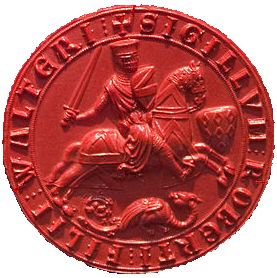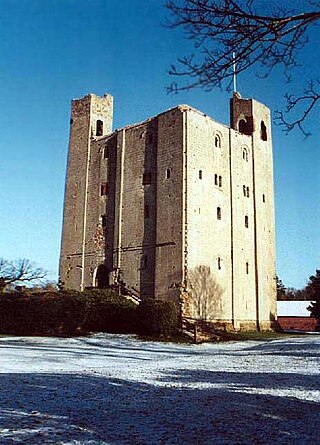
Richard de Montfichet (or Richard de Munfichet) (died 1267) was a Magna Carta surety. He was a landowner in Essex. [1]

Richard de Montfichet (or Richard de Munfichet) (died 1267) was a Magna Carta surety. He was a landowner in Essex. [1]
He was the son of another Richard de Montfichet, whom Henry II made forester of Essex. Richard the elder was the son of Gilbert, who married Avelina de Lucy, daughter of Richard de Luci. Richard the elder was the grandson of William de Montfichet, founder of the abbey of Stratford-Langton Essex; [2] he was with Richard I in Normandy in 1195, was sheriff of Essex and Hertfordshire in 1202, and died the next year, leaving one son by his wife Milisent. [3] William de Warenne offered King John 500 marks for a licence to marry the widow Melisent. [4]
The young Richard was then about ten years old, and was at first a ward of Roger de Lacy (1170-1211). He appears as witnessing several charters in 1214, and on 21 June 1215 received charge of the forests of Essex as his by hereditary right. He had nevertheless acted previously with the baronial party, and been present at the meeting at Stamford in March.
He was one of the twenty-five barons appointed to enforce the observance of Magna Carta, and as a prominent member of the party was excommunicated by the pope in 1216. He supported Louis VIII of France both before and after John's death, and fighting at Lincoln against William Marshal on 20 May 1217 was then taken prisoner. He returned to loyalty, and recovered his lands in the following October. [3]
In 1223, his lands were again for a time seized by the king in consequence of his presence at a prohibited tournament at Blyth. In 1225, he was a justice-itinerant for Essex and Hertfordshire, and in the same year was a witness to the confirmation of Magna Carta. In 1234, he was admitted to sit as a baron of the exchequer, and in 1236 again witnessed the confirmation of the charter. He was justice of the forest for nineteen counties in 1237, and from 1242 to 1246 sheriff of Essex and Hertfordshire, the counties in which his estates lay. [3]
Montfichet was one of the baronial representatives on the committee to consider the king's demand for a subsidy in 1244, and probably, therefore. had a share in drafting the remarkable scheme of reform of that year. [3]
He married first Alice (fl. 1217), and then. Jousa or Joyce. [2] He died in 1267 without issue, and his estates passed to the children of his three sisters. Montfichet is of chief note for his share in the struggle for the charter. He was the last survivor of the twenty-five; his age probably prevented his taking any part in the later barons' war, which he outlived. [3]
![]() This article incorporates text from a publication now in the public domain : Kingsford, Charles Lethbridge (1894). "Montfichet, Richard de". In Lee, Sidney (ed.). Dictionary of National Biography . Vol. 38. London: Smith, Elder & Co.
This article incorporates text from a publication now in the public domain : Kingsford, Charles Lethbridge (1894). "Montfichet, Richard de". In Lee, Sidney (ed.). Dictionary of National Biography . Vol. 38. London: Smith, Elder & Co.

Magna Carta Libertatum, commonly called Magna Carta or sometimes Magna Charta, is a royal charter of rights agreed to by King John of England at Runnymede, near Windsor, on 15 June 1215. First drafted by the Archbishop of Canterbury, Cardinal Stephen Langton, to make peace between the unpopular king and a group of rebel barons, it promised the protection of church rights, protection for the barons from illegal imprisonment, access to swift and impartial justice, and limitations on feudal payments to the Crown, to be implemented through a council of 25 barons. Neither side stood by their commitments, and the charter was annulled by Pope Innocent III, leading to the First Barons' War.

Gilbert de Clare, 4th Earl of Hertford, 5th Earl of Gloucester, 1st Lord of Glamorgan, 7th Lord of Clare was the son of Richard de Clare, 3rd Earl of Hertford (c. 1153–1217), from whom he inherited the Clare estates. He also inherited from his mother, Amice Fitz William, the estates of Gloucester and the honour of St. Hilary, and from Rohese, an ancestor, the moiety of the Giffard estates. In June 1202, he was entrusted with the lands of Harfleur and Montrevillers.

Sir Robert de Ros was an Anglo-Norman feudal baron, soldier and administrator who was one of the twenty-five barons appointed under clause 61 of Magna Carta to monitor its observance by King John of England.

William Marshal, 2nd Earl of Pembroke was a medieval English nobleman and was one of the sureties of Magna Carta. He fought during the First Barons' War and was present at the Battle of Lincoln (1217) alongside his father William Marshal, 1st Earl of Pembroke, who led the English troops in that battle. He commissioned the first biography of a medieval knight to be written, called L'Histoire de Guillaume le Mareschal, in honour of his father.

Robert Fitzwalter was one of the leaders of the baronial opposition against King John, and one of the twenty-five sureties of Magna Carta. He was feudal baron of Little Dunmow, Essex and constable of Baynard's Castle, in London, to which was annexed the hereditary office of castellan and chief knight banneret of the City of London. Part of the official aristocracy created by Henry I and Henry II, he served John in the wars in Normandy, in which he was taken prisoner by King Philip II of France and forced to pay a heavy ransom.

William d'Aubigny or D'Aubeney or d'Albini, Lord of Belvoir was a prominent member of the baronial rebellions against King John of England. He was one of the signatories of Magna Carta.

Ranulf de Blondeville, 6th Earl of Chester and 1st Earl of Lincoln, known in some references as the 4th Earl of Chester, was one of the "old school" of Anglo-Norman barons whose loyalty to the Angevin dynasty was consistent but contingent on the receipt of lucrative favours. He has been described as "almost the last relic of the great feudal aristocracy of the Conquest".

Aubrey de Vere, 2nd Earl of Oxford, hereditary Master Chamberlain of England, served in military campaigns under King Richard and King John. He was succeeded in the earldom by his brother, Robert de Vere, 3rd Earl of Oxford.
Montfichet's Tower was a Norman fortress on Ludgate Hill in London, between where St Paul's Cathedral and City Thameslink railway station now stand. First documented in the 1130s, it was probably built in the late 11th century. The defences were strengthened during the revolt of 1173–1174 against Henry II.

Eustace de Vesci (1169–1216) was an English lord of Alnwick Castle, and a Magna Carta surety. He also held lands in Sprouston, Roxburghshire, Scotland as brother in-law to King Alexander II of Scotland. Eustace was a leader during the Barons' War in 1215 and was killed while undertaking a siege of Barnard Castle in 1216.
Sir Thomas Moulton was an English landowner, knight, admiral and judge during the reigns of King John and King Henry III. From a family with landholdings in the south of Lincolnshire, he was the son and heir of Thomas Moulton and his wife Eleanor Boston. After initial military service, he became a senior judge and held important government positions, in the process extending his inherited estates and accumulating considerable wealth.
Alan la Zouche (1205–1270) was an Anglo-Norman nobleman and soldier of Breton descent. He built the Zouches Manor in Cambridgeshire. He was High Sheriff of Northamptonshire from 1261 to 1266.

William I de Cantilupe 1st feudal baron of Eaton (Bray) in Bedfordshire, England, was an Anglo-Norman royal administrator who served as steward of the household to King John and as Baron of the Exchequer.

Alan Basset was an English baron.

Hugh de Neville was the Chief Forester under the kings Richard I, John and Henry III of England; he was the sheriff for a number of counties. Related to a number of other royal officials as well as a bishop, Neville was a member of Prince Richard's household. After Richard became king in 1189, Neville continued in his service and accompanied him on the Third Crusade. Neville remained in the royal service following Richard's death in 1199 and the accession of King John to the throne, becoming one of the new king's favourites and often gambling with him. He was named in Magna Carta as one of John's principal advisers, and considered by a medieval chronicler to be one of King John's "evil counsellors". He deserted John after the French invasion of England in 1216 but returned to pledge his loyalty to John's son Henry III after the latter's accession to the throne later that year. Neville's royal service continued until his death in 1234, though by then he was a less significant figure than he had been at the height of his powers.
Beatrix de Vesci of Alnwick Castle, was an eleventh-century medieval noble lady of house de Vesci.
William de Mowbray, lord of Thirsk and Mowbray, was a Norman lord and English noble who was one of the twenty-five executors of Magna Carta. He was described as being as small as a dwarf but very generous and valiant.

The Marshal of the Army of God and the Holy Church was the title displayed from 1215 by Robert Fitzwalter, the leader of the baronial opposition against John, King of England and one of the twenty-five sureties of Magna Carta. He was feudal baron of Little Dunmow, Essex and constable of Baynard's Castle, in London, to which was annexed the hereditary office of castellain and chief banneret of the City of London. He was elected by his fellow barons, and held the title at least from when the rebels armed themselves in Lincolnshire and formally defied King John. He retained the title at least until he received back the custody of Hertford castle in June. He died on 9 December 1235, and is buried in the Priory Church in Little Dunmow.
The de Montfitchet family were of Norman origin, probably from the town of Montfiquet. Robert Gernon received manorial lands in Essex in reward for his service prior to publication of the Domesday Book in 1086, and his family were subsequently based there, initially in the castle at Stansted Mountfitchet. They lasted for five generations before becoming extinct when Richard de Montfichet died without issue in 1258. Other early attested spellings include Munfichet, Muntfichet, Montefixo, and Mufchet; while later variants include Mountfiquit and Montfiket.